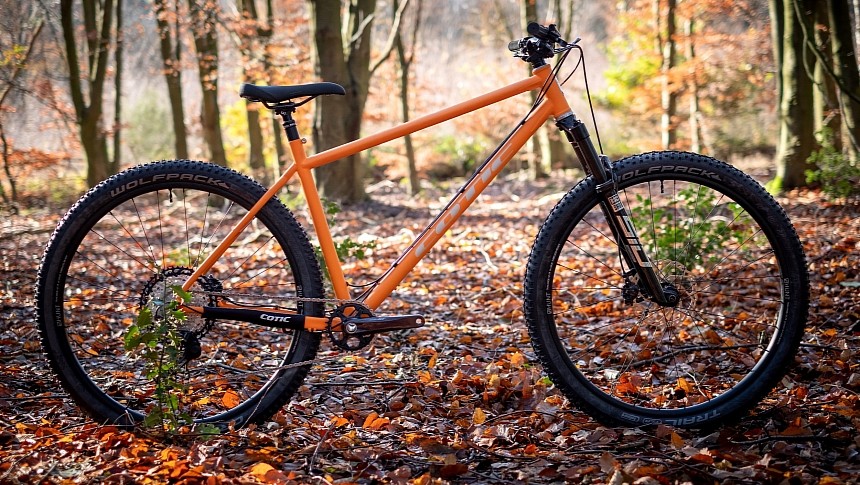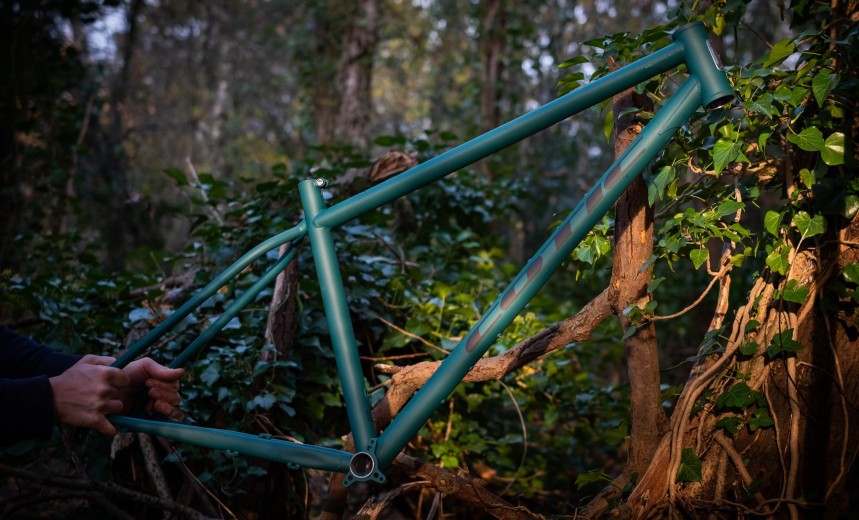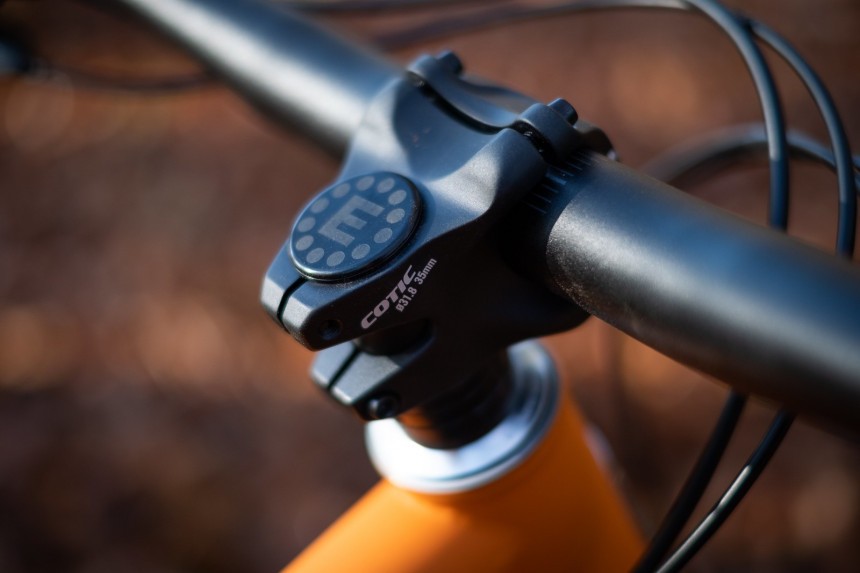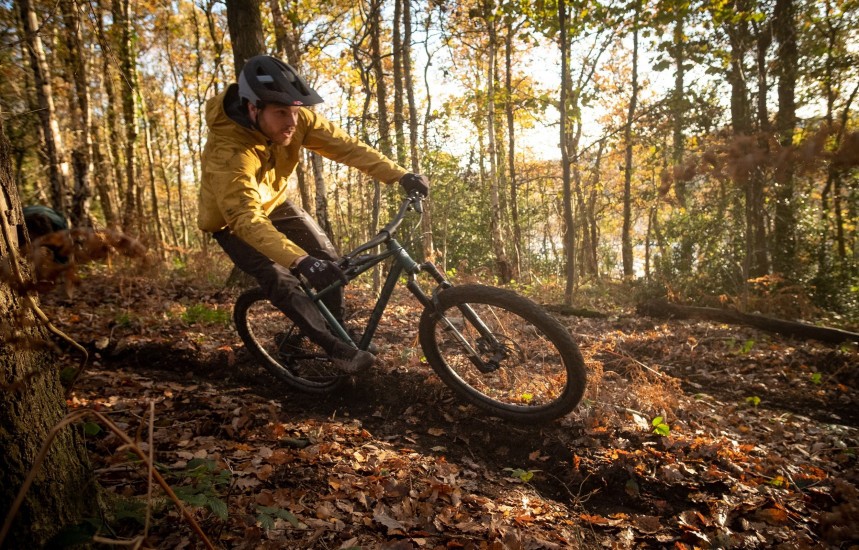"Ok, sure, I get it. Still, is road-bike steel good enough for MTBs?" "Why wouldn't it be?" "Well, the stresses exerted while hauling butt around those trails just make me feel like we shouldn't be riding this." "Oh, but we should!"
It may be difficult to pick up on exactly what the two characters above are talking about, but it's not like the main photo didn't tell you that today's topic of discussion is a bicycle, in particular, Cotic's newest Solaris, a hardtail MTB created to be nimble, light, and able to perform in countless settings.
Now, all that sounds nice and all, but we really need to take a closer look at the Solaris, as it's built a bit differently than your average hardtail. Mainly, I'm referring to the fact that this beauty is crafted with nothing more than Reynolds 853 steel, a mix of carbon, manganese, chrome, molybdenum, silicon, and copper. Basically, it's Chromoly on steroids.
Furthermore, 853 steel is hardened under air cooling and then heat treated. This results in steel whose strength can actually increase after the whole heating and cooling process is completed. This means thinner, thus lighter tubes with high resistance to stress, the sort of stuff cyclists want and the main reason why this still reigned king among bicycles during the 90s and onward, but mostly in the road biking world.
As time moved forward, and more and more folks played around with this metal, Cotic included, we figured out that it also makes one solid MTB, especially once mixed in with suspension systems and all that. However, the Solaris is a hardtail - my kind of pony - so this one's all about whipping it around the local woods or singletracks. Or is it?
There are a few other benefits to using steel to craft a bicycle, and this includes steel's innate ability to bend before breaking, unlike carbon fiber and aluminum, and the fact that steel is much cheaper to work with, and those savings are often transferred to the customer. For example, a Solaris frame will run you no more than £1,000 ($1,300 at current exchange rates) if shipped within the UK, Cotic's home country.
With the goods that make up this bike out of the way, let's dive a tad deeper into what Cotic has achieved here, and all that starts off with a pair of 29-inch tires. These babies are all about coasting over debris and doing it quickly, all the while that elongated and sleek forward triangle drops out of the way near the seat tube in case you encounter any drops along the way.
At the rear of the Solaris, Cotic also includes their "signature" wishbone seat stay design, and while it allows nice and large cross-section tires to be added to the Solaris, among others - mainly during production - whether or not this feature affects handling or stiffness in any way is a very debated topic. But, Cotic does add their signature gussets to improve resistance to fatigue. If you look closely, more gussets can be spotted all over the frame.
Then there's that nearly inexistent 35 mm (1.4 in) stem and optimized head tube angle, all part of Cotic's Longshot geometry that's meant to bring absolute control over what that front wheel does and where it goes; the rear will follow. This includes slack head tube angles and long wheelbases to ensure the rider sits between those wheels with peak stability.
Now, the Solaris is clearly an MTB. Still, there's a neat trick up its sleeve that Cotic also worked into this machine's design: the ability to stick through those long hauls. You know, those trips that take you further than ever before and even camp out at the end of your route.
I'm talking about all the cargo mounts we see tattered all over the frame's tubes. Wait, what cargo mounts? Well, they're there, and you can't see them because Cotic hides them in plain sight; the brake and shifter line routers are also the bosses. A neat little feature, and once you realize just how many such points are on that frame, you should have no trouble picturing this bike packed to the brim with cargo bags.
This means that you can whip your Solaris around the local landscape this weekend and, next weekend, load it up with tools, food, and a tent, ride out of town, set up camp, and see what other lands have to offer. A trick that's not to be overlooked. While completed Solaris bikes are available from the manufacturer, we can also select a rigid front fork crafted from carbon fiber straight off the assembly line, transforming this MTB into something a bit more twisted.
As for those completed setups that Cotic offers, the least expensive cruises in with a price tag of £2,200 ($2,800) and include a Shimano drivetrain and brakes, while the top shelf stuff is full of names like Garbaruk, Hope, and RockShox, just to name a few. Those versions, as there are two, are going for at least £6,550 ($8,250). Do check out the other in-between options, as there are a few.
I'd prefer to grab one of these juicy frames bare and throw on the components I've come to love and ride with. Then again, maybe I choose to explore a different layout. Maybe next year, I'll switch it up again, and the year after that, too. After all, we've got ourselves a rather versatile and solid frame to work with.
Now, all that sounds nice and all, but we really need to take a closer look at the Solaris, as it's built a bit differently than your average hardtail. Mainly, I'm referring to the fact that this beauty is crafted with nothing more than Reynolds 853 steel, a mix of carbon, manganese, chrome, molybdenum, silicon, and copper. Basically, it's Chromoly on steroids.
Furthermore, 853 steel is hardened under air cooling and then heat treated. This results in steel whose strength can actually increase after the whole heating and cooling process is completed. This means thinner, thus lighter tubes with high resistance to stress, the sort of stuff cyclists want and the main reason why this still reigned king among bicycles during the 90s and onward, but mostly in the road biking world.
As time moved forward, and more and more folks played around with this metal, Cotic included, we figured out that it also makes one solid MTB, especially once mixed in with suspension systems and all that. However, the Solaris is a hardtail - my kind of pony - so this one's all about whipping it around the local woods or singletracks. Or is it?
With the goods that make up this bike out of the way, let's dive a tad deeper into what Cotic has achieved here, and all that starts off with a pair of 29-inch tires. These babies are all about coasting over debris and doing it quickly, all the while that elongated and sleek forward triangle drops out of the way near the seat tube in case you encounter any drops along the way.
At the rear of the Solaris, Cotic also includes their "signature" wishbone seat stay design, and while it allows nice and large cross-section tires to be added to the Solaris, among others - mainly during production - whether or not this feature affects handling or stiffness in any way is a very debated topic. But, Cotic does add their signature gussets to improve resistance to fatigue. If you look closely, more gussets can be spotted all over the frame.
Now, the Solaris is clearly an MTB. Still, there's a neat trick up its sleeve that Cotic also worked into this machine's design: the ability to stick through those long hauls. You know, those trips that take you further than ever before and even camp out at the end of your route.
I'm talking about all the cargo mounts we see tattered all over the frame's tubes. Wait, what cargo mounts? Well, they're there, and you can't see them because Cotic hides them in plain sight; the brake and shifter line routers are also the bosses. A neat little feature, and once you realize just how many such points are on that frame, you should have no trouble picturing this bike packed to the brim with cargo bags.
As for those completed setups that Cotic offers, the least expensive cruises in with a price tag of £2,200 ($2,800) and include a Shimano drivetrain and brakes, while the top shelf stuff is full of names like Garbaruk, Hope, and RockShox, just to name a few. Those versions, as there are two, are going for at least £6,550 ($8,250). Do check out the other in-between options, as there are a few.
I'd prefer to grab one of these juicy frames bare and throw on the components I've come to love and ride with. Then again, maybe I choose to explore a different layout. Maybe next year, I'll switch it up again, and the year after that, too. After all, we've got ourselves a rather versatile and solid frame to work with.

















